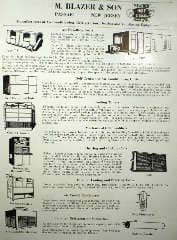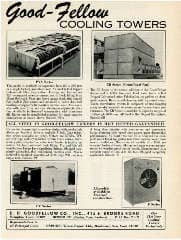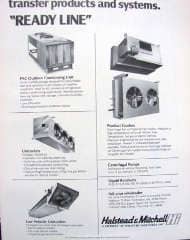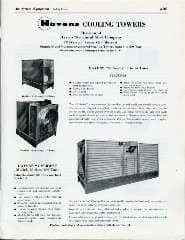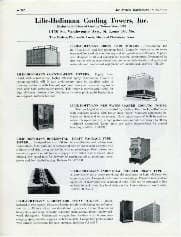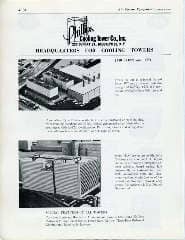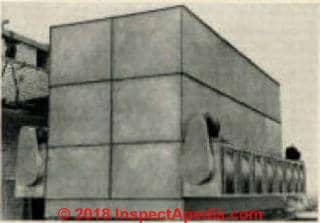 Asbestos in Cooling Towers
Asbestos in Cooling Towers
- POST a QUESTION or COMMENT about the use of asbestos in cooling towers and similar roofop HVAC equipment
Asbestos in Cooling Towers
This article describes the uses of asbestos, typically fibre-cement panels, in cooling towers. We include research on the health effects of asbestos contamination in cooling tower water.
This article series provides a master list of the forms in which asbestos was used, a list of known asbestos-containing materials, and links to detailed articles about individual asbestos-containing products & materials found in buildings and in a wide range of products used in both home and industry.
InspectAPedia tolerates no conflicts of interest. We have no relationship with advertisers, products, or services discussed at this website.
- Daniel Friedman, Publisher/Editor/Author - See WHO ARE WE?
Asbestos use in Cooling Towers
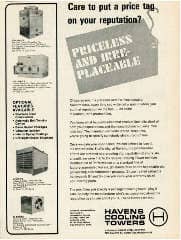 Asbestos in cooling towers - asbestos cement panels were used as side panels, top covers, and louvers in cooling towers in North America and we think in other countries as early as 1930.
Asbestos in cooling towers - asbestos cement panels were used as side panels, top covers, and louvers in cooling towers in North America and we think in other countries as early as 1930.
Asbestos may also have been used as an infill or insulating fill between cooling tower panel surfaces. In these forms the asbestos found in cooling towers may be in either non-firable or potentially-friable forms.
Asbestos-containing caulk may also have been used on cooling towers.
Asbestos was also used as coolling tower piping in some installations at least in the UK and in cooling towers at some U.S. nuclear power stations.
[Click to enlarge any image]
In North America by the early 1940's (or earlier), asbestos was found in many if not all asbestos-cement or "fibro-cement" cooling tower components made by most cooling tower-producing companies listed below, including, for example, the Marley company's honeycomb-type draft blocking panels and other cooling tower panels that may combine asbestos and a plastic coating.
A patent search finds other cooling tower manufacturers using asbestos fibro-cement panels in tower panels including Good-Fellow Cooling Towers and Havens Cooling Towers [Advertisement shown above]
A review of older ASTM standards also documents cooling tower asbestos in ASTM C1081 - 98(2014) -
Standard Specification for Asbestos-Cement Corrugated Fill For Use in Cooling Towers - now obsolete.
In some older cooling towers you may also find more-generic asbestos cement panels made by any of a wide range of manufacturers. Asbestos cement was used as cooling tower side panels and louvers.
References for Asbestos Use in Cooling Towers
These links along with copies of advertisements for cooling towers from the companies listed below provide additional details about the use of asbestos in cooling towers.
- M. Blazer & Son Cooling Towers, Passaic New Jersey USA, manufacturer of HVAC equipment. Shown above: an advertisement ofr M Blazer cooling towers. [Click to enlarge any image]
- E.D. Goodfellow Co., Inc., 415 E. Brooks Road, Memphis TN 38102 provide of PVA, PV, and CB-series cooling towers and other products. Castings and louvers were manufactured using 3/8" corrugated asbestos cement board.
- Halstead & Mitchell HVAC equipment, produced by a division of Halstead Industries, included cooling towers with fireproof asbestos fill. HALSTEAD & MITCHELL COOLING TOWER ADVERTISEMENT [Image) Halstgead1978.
- Havens Cooling Towers, division of Havens Steel Company, 7218 E. 17th Street, Kansas City MO 64126 USA used treated asbestos honeycomb fill in cooling tower panels.
- Lilie-Hoffman Cooling Towers, Inc., 1450 So. Vanderventer Ave., St. Louis 10, MO, plants in St. Louis MO and Plainview TX, producing cooling towers since 1898.
- Marley Company, 222 W. Gregory, Kansas Cityy 13 Missouri USA, water cooling towers, spray nozzles, including Marley-CMarley Cooling Towers, using asbestos filled neoprene panels, fastory assembled, advertisement from 1967, producing cooling towers from 1940 or earlier. A Marley cooling tower ad is shown above.
- M. Blazer & Sons Cooling Towers, Passaic New Jersey, USA, used transite asbestos panels in "completely fireproof" cooling towers, Advertisement shown above.
- North Street Cooling Towers (P) Ltc., fC-14, Sector 22, Meerut Road Indusgtrial Area, Ghaziabad UP, India [contemporary]
- Phillips Cooling Tower Co., 220 Dupon St., Brooklyn, NY USA, cooling towers using redwood or steel framing, using corrugated cement asbestos board casing laid horizontally, fastened to the frame - see Advertisement.
- Lewis, Barbara-Ann G., ASBESTOS IN COOLING-TOWER WATERS [PDF] ANL/ES-63, (1977) Argonne National Laboratory, Argonne IL, prepared for the U.S. Nuclear Regulatory Commission under contract W-31-109-Eng-38. - Retrieved 2018/-4/22, original source: https://www.osti.gov/servlets/purl/5057141
- Lewis, Barbara-Ann G., Asbestos in Cooling Tower Waters, Final Report (1979) Argonne National Laboratory, Argonne IL,
Abstract: Water discharges from cooling towers constructed with asbestos fill were found to contain chrysotile--asbestos fibers at concentrations as high as 108 fibers/liter. The major source of these fibers, appears to be the components of the towers rather than the air drawn through the towers or the makeup water taken into the towers.
Suggested mechanisms for the release of chrysotile fibers from cooling-tower fill include freeze-thaw cycles and dissolution of the cement due to acidic components of the circulating water.
Ash- or other material-settling ponds were found to reduce asbestos-fiber concentrations in cooling-tower effluent. The literature reviewed did not support the case for a causal relationship between adverse human health effects and drinking water containing on the order of 106 chrysotile--asbestos fibers/liter; for this and other reasons, it is not presently suggested that the use of asbestos fill be discontinued.
However, caution and surveillance are dictated by the uncertainties in the epidemiological studies, the absence of evidence for a safe threshold concentration in water, and the conclusive evidence for adverse effects from occupational exposure.
It is recommended that monitoring programs be carried out at sites where asbestos fill is used; data from such programs can be used to determine whether any mitigative measures should be taken.
On the basis of estimates made in this study, monitoring for asbestos in drift from cooling towers does not appear to be warranted - Asbestos products and their history and use in various building materials such as asphalt and vinyl flooring includes discussion which draws on ASBESTOS, ITS INDUSTRIAL APPLICATIONS, ROSATO 1959, D.V. Rosato, engineering consultant, Newton, MA, Reinhold Publishing, 1959 Library of Congress Catalog Card No.: 59-12535 (out of print, text and images available at InspectAPedia.com).
This article series is an expanded, illustrated list of the applications of asbestos in a wide range of products and is an adaptation from Table 1.7. Asbestos Applications a list provided by Rosato (1959)[1] and discussed at ASBESTOS PRODUCTS 1959 [live link above].
There we provide a master list of manufactured products that contain asbestos.
Common asbestos-containing building materials are illustrated separately at ASBESTOS PHOTO GUIDE to MATERIALS our extensive photo library.
Note that asbestos may be present in still other substances and even products, not by its deliberate use or design, but because it occurs naturally, such as asbestos that is found in some talc powders (amphibole asbestos).
Note that while this is the most extensive list of asbestos-containing products & materials it is of course incomplete, as asbestos was used in thousands of products and materials and is still used in many.
CONTACT US to add items and photographs to this list of asbestos containing materials.
...
Continue reading at ASBESTOS LIST of PRODUCTS - topic home, master list, or select a topic from the closely-related articles below, or see the complete ARTICLE INDEX.
Or see these
Recommended Articles
- ASBESTOS IDENTIFICATION IN BUILDINGS
- ASBESTOS PRODUCTS 1959 - returns to the chapter in ASBESTOS ORIGIN & NATURE where Rosato's Table 1.7 originally appeared.
- ASBESTOS PRODUCING COMPANIES & TRUSTS for a most-complete list of companies that produced products containing asbestos
- ASBESTOS PHOTO GUIDE to MATERIALS
Suggested citation for this web page
ASBESTOS in COOLING TOWERS at InspectApedia.com - online encyclopedia of building & environmental inspection, testing, diagnosis, repair, & problem prevention advice.
Or see this
INDEX to RELATED ARTICLES: ARTICLE INDEX to ASBESTOS HAZARDS
Or use the SEARCH BOX found below to Ask a Question or Search InspectApedia
Ask a Question or Search InspectApedia
Questions & answers or comments about what building products and common in-building products, appliances, mechanical components were produced using asbestos materials.
Try the search box just below, or if you prefer, post a question or comment in the Comments box below and we will respond promptly.
Search the InspectApedia website
Note: appearance of your Comment below may be delayed: if your comment contains an image, photograph, web link, or text that looks to the software as if it might be a web link, your posting will appear after it has been approved by a moderator. Apologies for the delay.
Only one image can be added per comment but you can post as many comments, and therefore images, as you like.
You will not receive a notification when a response to your question has been posted.
Please bookmark this page to make it easy for you to check back for our response.
IF above you see "Comment Form is loading comments..." then COMMENT BOX - countable.ca / bawkbox.com IS NOT WORKING.
In any case you are welcome to send an email directly to us at InspectApedia.com at editor@inspectApedia.com
We'll reply to you directly. Please help us help you by noting, in your email, the URL of the InspectApedia page where you wanted to comment.
Citations & References
In addition to any citations in the article above, a full list is available on request.
- 16 CFR Chapter 11, Consumer Products Containin Asbestos, Advance Notice of Proposed Rulemaking", [PDF] U.S. Consumer Products Safety Commission, CPSC, U.S. Federal Register, Vol. 44. No 201, 17 October 1979, Proposed Rules, 60057. This document cites a long list of consumer products that contained asbestos.
- Asbestos NESHAP ADEQUATELY WET ASBESTOS GUIDANCE, EPA340/1-90-019, December 1990, U.S. ENVIRONMENTAL PROTECTION AGENCY, Office of Air Quality Planning and Standards, Stationary Source Compliance Division, Washington, DC 20460,original web source: http://www.epa.gov/region04/air/asbestos/awet.htm
- Asbestos products and their history and use in various building materials such as asphalt and vinyl flooring includes discussion which draws on ASBESTOS, ITS INDUSTRIAL APPLICATIONS, ROSATO 1959, D.V. Rosato, engineering consultant, Newton, MA, Reinhold Publishing, 1959 Library of Congress Catalog Card No.: 59-12535 (out of print, text and images available at InspectAPedia.com).
- In addition to citations & references found in this article, see the research citations given at the end of the related articles found at our suggested
CONTINUE READING or RECOMMENDED ARTICLES.
- Carson, Dunlop & Associates Ltd., 120 Carlton Street Suite 407, Toronto ON M5A 4K2. Tel: (416) 964-9415 1-800-268-7070 Email: info@carsondunlop.com. Alan Carson is a past president of ASHI, the American Society of Home Inspectors.
Thanks to Alan Carson and Bob Dunlop, for permission for InspectAPedia to use text excerpts from The HOME REFERENCE BOOK - the Encyclopedia of Homes and to use illustrations from The ILLUSTRATED HOME .
Carson Dunlop Associates provides extensive home inspection education and report writing material. In gratitude we provide links to tsome Carson Dunlop Associates products and services.


